By Aaron J. Heller
As I write this, firefighters are preparing their Class A uniforms and planning a funeral to say goodbye to one of our own, taken from us far too early in another commercial building fire.
Whether you live in a big city, a suburban community, or a rural farm town, big box stores are moving in and making an impact on everything from the economy to traffic woes to the local fire department.
As these commercial hubs evolve, so must our understanding that these are not the bread-and-butter jobs to which many of us are accustomed. Even for the well-staffed and well-equipped fire departments, big box stores present hazards not normally encountered on a regular basis. Knowing this is half the battle. Understanding that the tactics we use on one- and two-family dwellings can’t be relied on in this type of fire can prevent tragedy.
It’s important to note that this article is not a recap of any highly publicized fires, nor is it an indictment of anyone involved in those incidents. Many reports have been written, studies conducted, and speeches given about those fires. The purpose of this article is to provide a framework for firefighters and fire officers to consider the next time the bells go off for a fire alarm, smoke in the building, or a structure fire at your local big box store.
As with any fire, understanding the building construction is imperative. If we don’t know how it’s constructed, how will we know how it may react under fire conditions? Furthermore, how can we predict fire and smoke travel?
The building
Roof Construction. Most of today’s big box stores consist of bar joist truss roof systems covered by lightweight steel Q-decking panels, which are tack-welded or riveted to the trusses. This is typically covered by several inches of insulation panels and then a roof covering of rubber or neoprene, which is often glued along the edges. You may also encounter a layer of stones on top, known as ballast, which is used to hold the covering in place in high winds. Ballasts are also added to prevent ultraviolet (UV) ray degradation of the roof covering (photo 1). Additionally, these flat roofs make an excellent location for the installation of photovoltaic (PV) systems. A large number of stores are going green and covering their roofs with PV arrays that cover almost the entire roof system. Kohl’s department stores actually advertise this through their public address system throughout the course of the day (photo 2).
 |
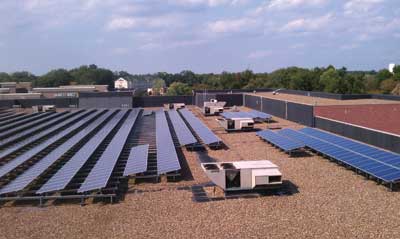 |
| Photos by author. |
Ventilation of these roof systems is rather controversial. Some departments allow crews to open the roof when deemed necessary for improved ventilation; others forbid cutting Q-decked flat roofs because firefighters cannot predict collapse. Also, the metal decking, when cut, has the serious potential to give way, sending firefighters into the building and the fire conditions below. If you allow cutting operations, be prepared to have multiple saws operating and enough personnel to remove the cut debris (photo 3). To err on the side of caution, many departments have elected to use existing roof openings such as skylights and roof hatches as a means of ventilation to alleviate some smoke and heat conditions without committing numerous crews to a dangerous location. Some newer structures have automatic smoke-removal systems incorporated into automatic alarm and suppression systems. Members should become familiar with these systems during inspections and preplanning.
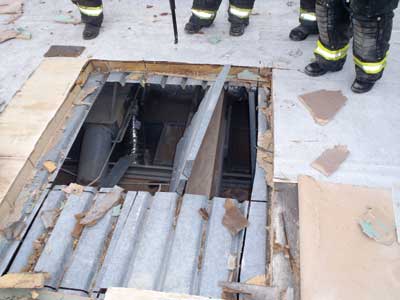
Walls. Most of the big box stores built in the past decade or so are of Type 2 construction. They are often concrete block or tilt-up concrete walls with a limited number of entry or exit doors on the B and D sides. In most cases, they have windows only in the front. The incident commander (IC) must consider this when formulating an incident action plan (IAP). Normally, the side doors are solely single or double doors used for emergency egress. These openings provide little means of ventilation but are useful as additional points for rescue, fire attack, and personnel emergency egress. On several occasions, fire departments have encountered exterior wall fires on these buildings. This is mainly because of the installation of foam, fiberglass, or composite panels on the exterior for decorative purposes. They do not add to the structural stability and may look like a combustible liquid fire from a distance! Be aware of mulch beds directly adjacent to these panels. There are many documented fires in commercial and residential buildings that were caused by mulch fires/exposures.
Parapets are common on big box stores (photo 4). The parapet is normally a free-standing continuation of a wall that protrudes above the roof line. For years it was primarily in the front or on the A side of the structure; now it is not uncommon for the entire building to have parapets. Consider a parapet during size-up, especially for truck company operations and roof access. One way to determine the height of a parapet from the roof to the top is to look for roof drains, which will show the roof level in relation to the top of the wall (photo 5). Carry additional ladders to the roof to descend over the raised parapet. Collapse is a major hazard involving these structures. Because the parapet is often free-standing, it is more susceptible to failure under fire conditions and to being knocked down inadvertently by master streams or accidental contact from aerial devices.

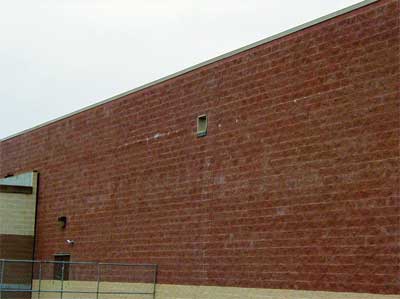
Building Obstacles. When preplanning, consider how the types and locations of obstacles will affect firefighting efforts. These stores will have many obstacles, including roll-down garage doors, security gates that may be roll-down and scissor style, locked and chained exterior fences and gates (especially in stores with lawn and garden centers), and a multitude of locking devices both commercially produced and homemade. Knowing what and where the obstacles are is a key to rapid entry and timely operations. Getting into these stores quickly, locating the seat of the fire, allowing for timely handline placement, and quickly starting searches will be the difference between a successful operation and a parking lot with victims (photo 6).
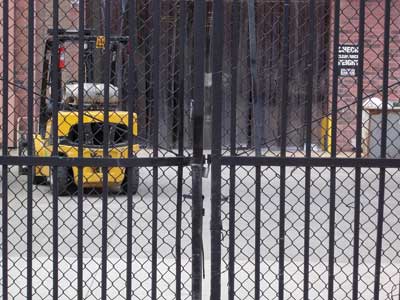
Fire Suppression Systems. One of the most important components of the big box store and of your IAP is the building’s fire suppression system. Because most of these structures are sprinklered, it is not uncommon for firefighters and occupants to be lulled into a false sense of security. The presence of automatic sprinkler systems is certainly a benefit to occupants and firefighters, but it is not a cure-all for fires in these structures.
Most of these buildings have more than one type of system. For example, the Wal-Mart in my first-due area has four separate types of systems: a standard wet system throughout the structure; a dry system in the exterior lawn and garden center and in the exterior overhangs; a wet deluge system in the auto repair section, which also contains the tire storage area; and a wet agent chemical system over the cooking appliances in the fast food restaurant, which is inside the lobby. All are separately activated, yet all are intrinsic components of the overall fire protection of this store (photo 7).
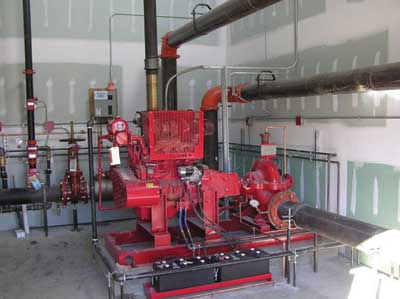
When conducting the IAP review for big box stores, the local fire officials have a responsibility to examine the proposed systems and become familiar with what they have in their response area. Know if the municipal water system can sustain initial firefighting efforts and whether the system encompasses special hazards such as paint or combustible fluid fires. The locations of the fire department connections (FDCs) must be made very clear, and the FDCs must have no access issues and be in close proximity to a hydrant for ease of supply. For example, in our municipality, there is a requirement that the hydrant must be within 50 feet of the FDC and the connection must meet the fire department’s specifications. This early planning during construction can alleviate confusion and obstacles when smoke and fire are showing from side A at 0400 hours!
Another concern when looking at suppression systems is whether the system still meets the requirements following a change of occupancy or simply a change of product placement within the building. Address this issue during preplanning and building inspections. Remember, these buildings have large, uncompartmented areas, which may complicate the initial handline stretch. Personnel must know where the standpipe connections are within the building and incorporate this in any fire attack plan. This knowledge can make or break the success of the incident. Because these systems are required to be tested and maintained annually doesn’t mean they don’t fall into disrepair. Have crews check FDCs and standpipe connections to ensure operability (photo 8).
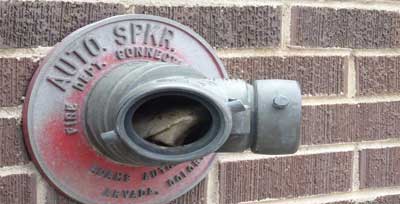
Contents and Hazards. Big box stores generally contain a huge variety of products and services that never have been associated with just one structure in the past. We now have super stores that have groceries, furniture, combustible liquids, clothing, auto repair centers, and lawn and garden centers with their associated hazmats.
In general, there are two basic functional areas of these stores: the sales floor and the warehouse/storage areas. In most cases, the sales floors are rather predictable, usually laid out in a grid, with items in their individual areas. For example, the clothing and shoes are not normally grouped with the paints and motor oils, and the fertilizers and lawn equipment are not with the furniture and toys.
However, the storage/warehouse area is not nearly as predictable (photos 9 and 10). It is not uncommon to have all of these contents within close proximity to each other in the warehouse. Officers formulating an IAP must keep this in mind. Storage/warehouse areas are quite often overloaded, making it difficult to maneuver a handline, especially under smoke conditions. Although you may have a very active and aggressive fire prevention bureau that conducts regular inspections and is looking out for the safety of line personnel and store occupants, many of these businesses will take their chances with fines over good housekeeping.
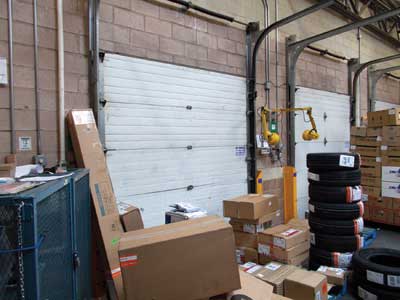
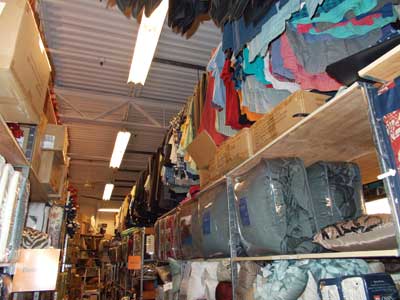
OPERATIONS
It should be apparent by now that fires in these structures are not the bread-and-butter bedroom jobs we are used to. However, there are some constants. The IC still has a responsibility to understand the structure and circumstances; the crew still must know their equipment and follow procedures.
Strategies and Tactics. Take every response seriously, whether for an activated fire alarm or an odor investigation. The company officer’s responsibility may be to simply direct the crew, yet in many communities the company officer may be the initial IC for a prolonged period until relieved, and he must know what he is facing. He must know, for example, what units are assigned to the box along with their capabilities and staffing levels and approximate response times. If he knows that each incoming unit is staffed only with a two-person crew, he should realize it may take multiple units to get the first interior attack line in service. This may also be the reason he may have to wait to make a push on the fire until the entire first alarm arrives.
At these fires, it is imperative to follow the incident command system. Officers must be able to work within the system and understand their orders and assigned tasks. The IC must expand the command structure as the fire becomes more complex.
Officers must be on top of accountability. Simply put, accountability is putting firefighters to work and knowing where they will be, what they will be doing, and the tactics they will use to complete their assignments. Accountability at this type of fire is of the utmost of importance.
Like in any incident, officers need to be looking forward and anticipating needs and potential issues or complications. A seasoned officer once told me that if you can BAG the fire you will be in front of it and not behind it. BAG stands for the following:
Where has the fire Been?
Where is the fire At?
Where is the fire Going?
This may seem sort of simplistic, but it has worked for me on several occasions. In big box stores, there are large uncompartmented areas to protect. If we can correctly answer these three questions, we may be able to put crews in the right positions and limit the progression of the fire while defending large portions of the structure or its exposures.
Engine Company Operations. When studying fires in these structures, we quickly realize the importance of solid engine company operations. The old fire service saying, “As the first line goes, so goes the fire,” couldn’t be more fitting here. Too many times we have seen large commercial fires attacked with 1½- and 1¾-inch handlines. This is a recipe for failure if there is any real fire volume. Such handlines may be easy to deploy and operate, but they do not provide the flow needed to suppress these fires. This has been made clear in several postincident critiques. The 2½-inch line as well as the portable monitor will provide the most knockdown capability, allow for better reach and penetration, and provide much more safety for interior operating crews.
Although some personnel prefer the ease of moving and operating the smaller lines, they need to be reminded of the lessons learned from stretching too small a line on previous fires of this magnitude. With practice, preplanning, and a focused group of engine company firefighters, the task of deploying and operating the larger lines becomes second nature and reduces the potential of being overrun by advancing fire conditions. These lines prove very useful in attacking the fire, defending exposures, and cooling the roof truss system to reduce the potential for collapse.
One concern must be the deflection of hose streams off the shelving and stock. Applying the water where needed is key, as is recognizing if the advance is making progress. Be careful to coordinate with search crews so they don’t knock goods from the shelves down on personnel, possibly injuring or trapping them.
Officers should realize they must have a sustainable water supply for the fire, engines supplied with large-diameter hose, and multiple water supplies. The need for multiple supply lines operating from more than one water system is very common in these fires. Factor in companies placing attack lines in service and supporting the sprinkler system. This may require long relay operations, which the IC should include in any IAP. Urban and suburban areas rely heavily on the municipal water system to provide needed fire flows; more rural neighborhoods may rely on water tenders as the source. Companies in rural regions must know their drafting and water shuttle capabilities if they have any hope of successfully fighting this type of fire. Additional alarms will be required from the onset; a well-planned and well-tested water operation is a must. Mastering such water supply operations takes practice and planning.
Truck Company Operations. Like at all structure fires, the work of truck companies is critical. The truck’s functions vary based on the situation and the department’s standard operating procedures (SOPs). Truck tasks at all of these fires include forcible entry, laddering, ventilation, search, and control of the building’s utilities. Without timely forcible entry, the operation will be hindered from the start. The truck companies assigned to these box alarms must be capable of overcoming the entry obstacles they will face-roll-down doors and gates, multiple locking devices, and well-constructed entry doors. Members’ mastery of metal cutting saws, hydraulic forcible entry tools, torches, and irons will be put to the test.
Laddering big box stores is not the same as laddering other structures, but it is required if anyone is sent to the roof. Ladder all sides of the structure-with multiple ladders, if possible, ranging from portable extension ladders to aerials to tower ladders-to give operating personnel as many safe exits as possible when committed to the roof. Secure portable ladders to immovable objects around the building; it is impractical to leave someone to foot each ladder. Consider the height of any parapet present, and use a straight or folding ladder to descend from the aerial to the roof if necessary.
Ventilation is a broad topic when it comes to these structures. Moving smoke and heated gases in these fires is critical to occupant survival and helps the engine companies move their lines into place. Some of these buildings are equipped with automatic smoke removal systems, which activate with the alarm or suppression system, and can include roof hatches that automatically open and ventilation systems that are meant to pull smoke from the structure. Familiarize yourself with these systems in your response areas.
Committing personnel to the roof for vertical ventilation is a major decision. If conditions allow, the IC must commit sufficient numbers of personnel with enough saws and blades to accomplish the task as quickly as possible. Performing cuts such as trench cuts on these roofs will eat up a lot of time and wear out tools and personnel. Remember, this is a time-sensitive task in a very dangerous location. Get the roof open and get off the structure. There is no need to remain above the fire admiring your work and looking like roof shepherds for the evening news! If your SOPs forbid roof cutting on these buildings, your alternative may be to simply vent all the needed skylights and hatches. This will take less time and still move some degree of smoke and heat from the building. Moving smoke is no easy task in these large stores. The use of several fans and fan trucks will be necessary. As the smoke becomes cooled from handlines and sprinkler systems, it becomes more difficult to move.
One of the most challenging truck company tasks will be searching for potential victims. Because of the size of these buildings, you have to have a search plan. A smoke-filled big box store can be and has been fatal for firefighters. Officers must consider the occupancy and time of day as part of their initial size-up to try to determine where victims may be in the building. For example, a fire in Wal-Mart at 1300 hours may have a large number of shoppers and all of the employees. They will be in the main shopping areas, office spaces, and warehouses. However, a fire in Pep Boys at 0300 hours will mean far fewer potential victims and locations such as stocking shelves or in the warehouse at the rear of the store. In both cases, a planned and focused search gives the victims the best chance for survival and allows firefighters the best opportunity to effect rescues of viable victims.
When conducting searches in large areas, use large-area search tactics; normal one- and two-family home search tactics will prove futile. Rope searches combined with the use of multiple thermal imaging cameras speed up the process and help maintain company integrity. Personnel are assigned an area to search, and you can track their progress and location relatively closely. Although you may not cover every inch of the store, personnel will work faster and more efficiently. Repetitive training in large-area search tactics is a must (photo 11). Searching straight aisles using a guide rope is relatively easy, but when searching areas with circular displays and racks, the rope can easily become tangled in stock if not properly managed.
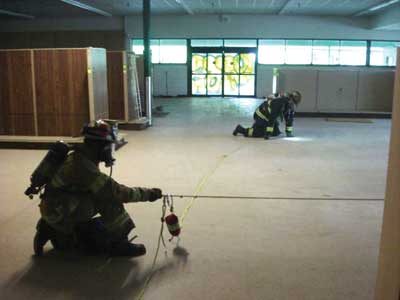
The utilities are another truck company responsibility. Controlling the natural gas, electric, and water are important jobs. Big box stores are fed by large services that, if uncontrolled, can cause severe injuries or death to operating personnel. Shutting off all utilities doesn’t eliminate all of the hazards associated with the gas and electric, but it will greatly reduce the chance of further complications.
Rapid Intervention Teams (RITs). Having trained and competent rapid intervention teams at these fires is a must. The sheer size of the building will require multiple RITs at any working fire. One RIT cannot sufficiently protect operating crews; incorporate multiple RITs into the box alarm plans. Assembling two to three is a good start; assign each crew a sector where firefighters are working. Also, ensure that crews are equipped to handle the type of construction they are facing.
Additional Considerations. Some considerations pertain to all responding personnel; arguably, the most important of these is air management. Firefighters and especially officers must know their capabilities while working in self-contained breathing apparatus. Someone at the command post or with the operations officer should maintain an air management log that tracks the entry times of interior personnel.
Also consider escape routes should conditions rapidly deteriorate. In several incidents, firefighters survived interior drop ceiling collapses because they were between shelving racks, which provided a safe void when the ceiling crashed down unexpectedly from fire impingement or the hose stream striking it. How many firefighters have died because they tried to exit from where they entered? This may not always be the best exit strategy. Sizing up the structure under normal operating conditions will provide crews with valuable knowledge should conditions deteriorate. Knowing your surroundings leads to better survivability.
Fires in big box stores are a challenge beyond the norm, but they are not insurmountable. With solid preplanning, properly staffed apparatus, and competent companies, you can lessen the severity of these fires and preserve lives and property. ICs must make the critical decisions on when to be aggressive, when to back crews out and go defensive, and how to proceed throughout the changing incident. These incidents require decisiveness and command presence and are not for the officer afraid to make the call!
AARON J. HELLER is a 30-year veteran of the fire service and a captain with the Hamilton Twp. (NJ) Fire District #9 in charge of training. He is a NJ level 2 instructor and a past chief of the New Egypt (NJ) Volunteer Fire Company. He is the owner of On Scene Training Associates, LLC, and an instructor with the Mercer County (NJ) Fire Academy.
Aaron J. Heller will present the workshop “Big Box Store Firefighting Strategies and Tactics” on Monday, April 7, 1:30 p.m.-5:30 p.m., at FDIC 2014 in Indianapolis.
Fire Engineering Archives

